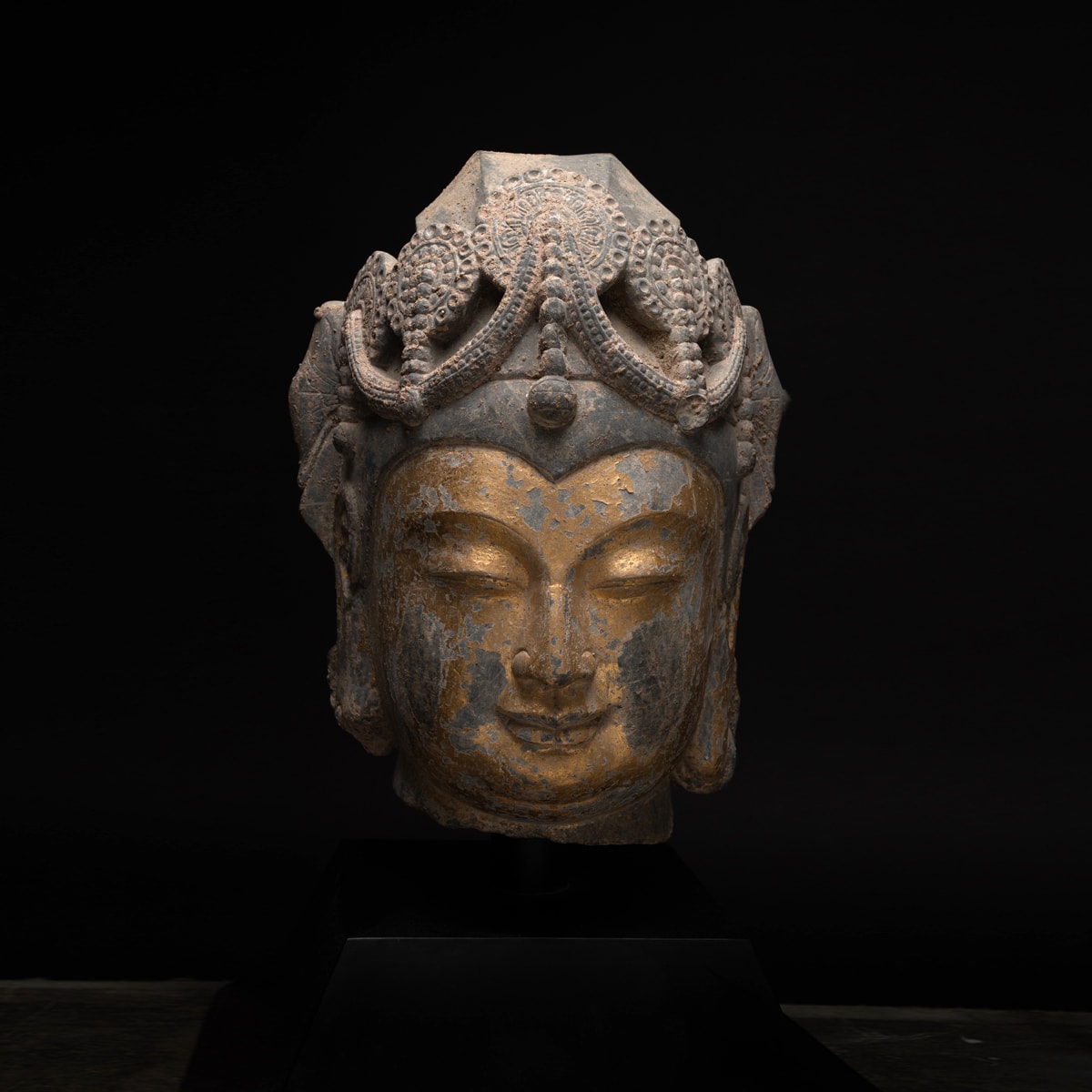Sui Gilt-Stone Head of a Bodhisattva, possibly Maitreya, 581 CE - 618 CE
Stone
43.2 x 27.9 cm
17 1/8 x 11 in
17 1/8 x 11 in
HK.2026
Further images
This is a sculpture of a Bodhisattva, possibly Maitreya, from Sui Dynasty. The head is characterized by fleshy features that harmonize the Sui dynasty’s emergent trend toward naturalism with the...
This is a sculpture of a Bodhisattva, possibly Maitreya, from Sui Dynasty. The head is characterized by fleshy features that harmonize the Sui dynasty’s emergent trend toward naturalism with the inherited idealized forms that conventionally conveyed the purity of Buddhist subjects. Here, the Bodhisattva’s broad arched brows and the sweep of the lowered lids lead the eye down the straight nose to the plump lips and slightly upturned chin, before following the softened jawline to the plump cheeks and returning upward to the crown of the head. The full oval face, gilded with gold, is counterbalanced above by a tall diadem richly carved with a stupa-like image and floral features. Even in its opulence, the diadem follows the standard Sui formula of a three-sided structure with aesthetic attention given to its band.
Considered the successor to the historical Shakyamuni Buddha, Maitreya is regarded as the Buddha of the Future and presides in the Tushita Heaven until his wisdom is required on earth. By Chinese calculation of the day, the influence of Shakyamuni’s teachings would end in the year AD 552 – roughly 1,000 years after the death of the historical Buddha – ushering in the period of the decline of Buddhist dharma. Such millennial speculation gave rise to the belief that decline and corruption were imminent and that the appearance of Maitreya as the Buddha of the Future could not be far away, which led to a surge in Maitreya’s popularity in the 6th century and the resultant increase in the number of Maitreya images created for worship.
The head belongs to a mature phase of Sui artistic production, when craftsmen synthesized styles from within and beyond China into graceful yet dynamic compositions that expressed the transcendental majesty of the Buddhist subject, diversifying the visual vocabulary of each region of the empire, while preserving established characteristics in production. Thus, this sculpture embodies the stylistic transition from the Northern Dynasties to Tang Dynasty.
Considered the successor to the historical Shakyamuni Buddha, Maitreya is regarded as the Buddha of the Future and presides in the Tushita Heaven until his wisdom is required on earth. By Chinese calculation of the day, the influence of Shakyamuni’s teachings would end in the year AD 552 – roughly 1,000 years after the death of the historical Buddha – ushering in the period of the decline of Buddhist dharma. Such millennial speculation gave rise to the belief that decline and corruption were imminent and that the appearance of Maitreya as the Buddha of the Future could not be far away, which led to a surge in Maitreya’s popularity in the 6th century and the resultant increase in the number of Maitreya images created for worship.
The head belongs to a mature phase of Sui artistic production, when craftsmen synthesized styles from within and beyond China into graceful yet dynamic compositions that expressed the transcendental majesty of the Buddhist subject, diversifying the visual vocabulary of each region of the empire, while preserving established characteristics in production. Thus, this sculpture embodies the stylistic transition from the Northern Dynasties to Tang Dynasty.











